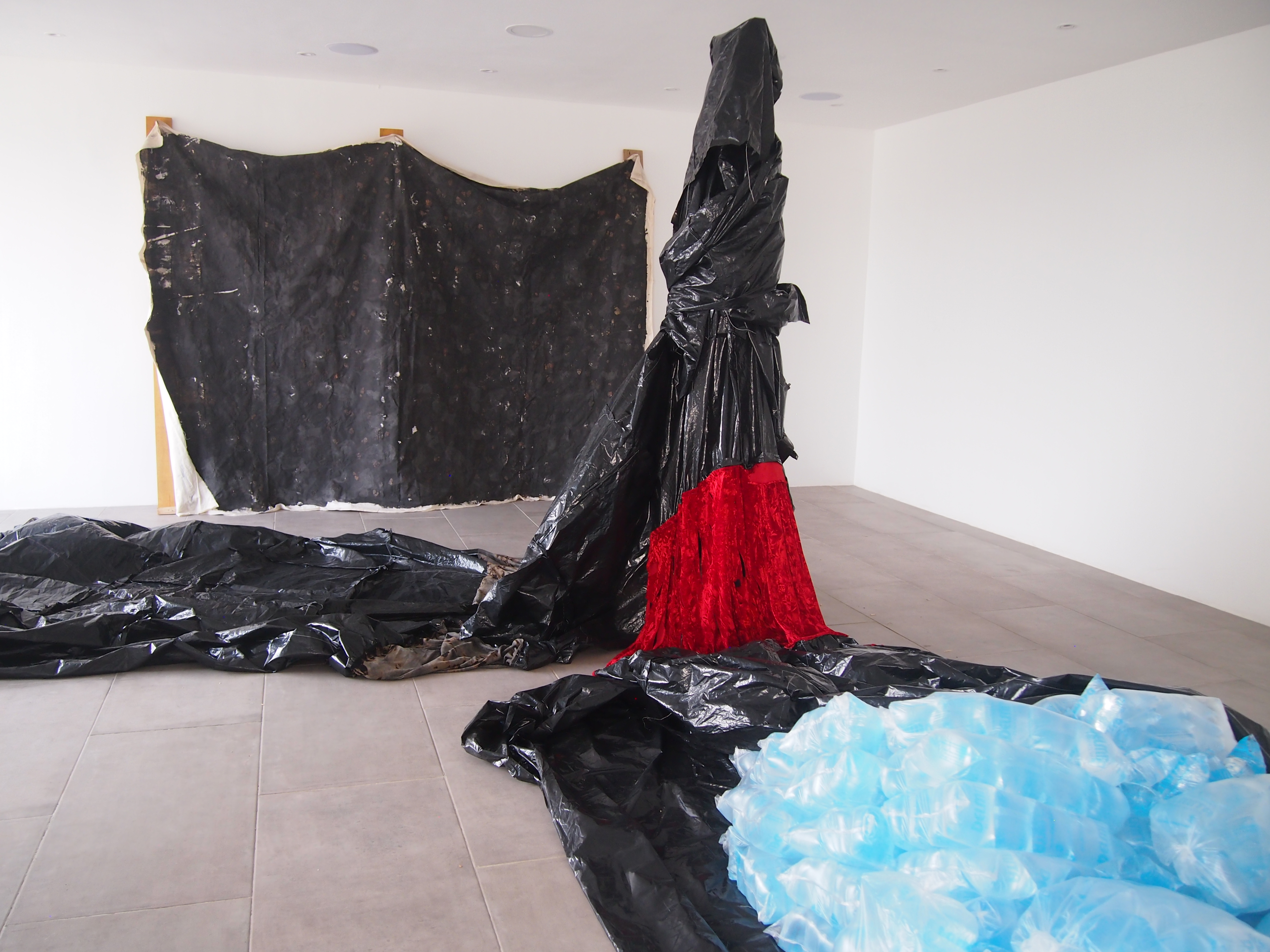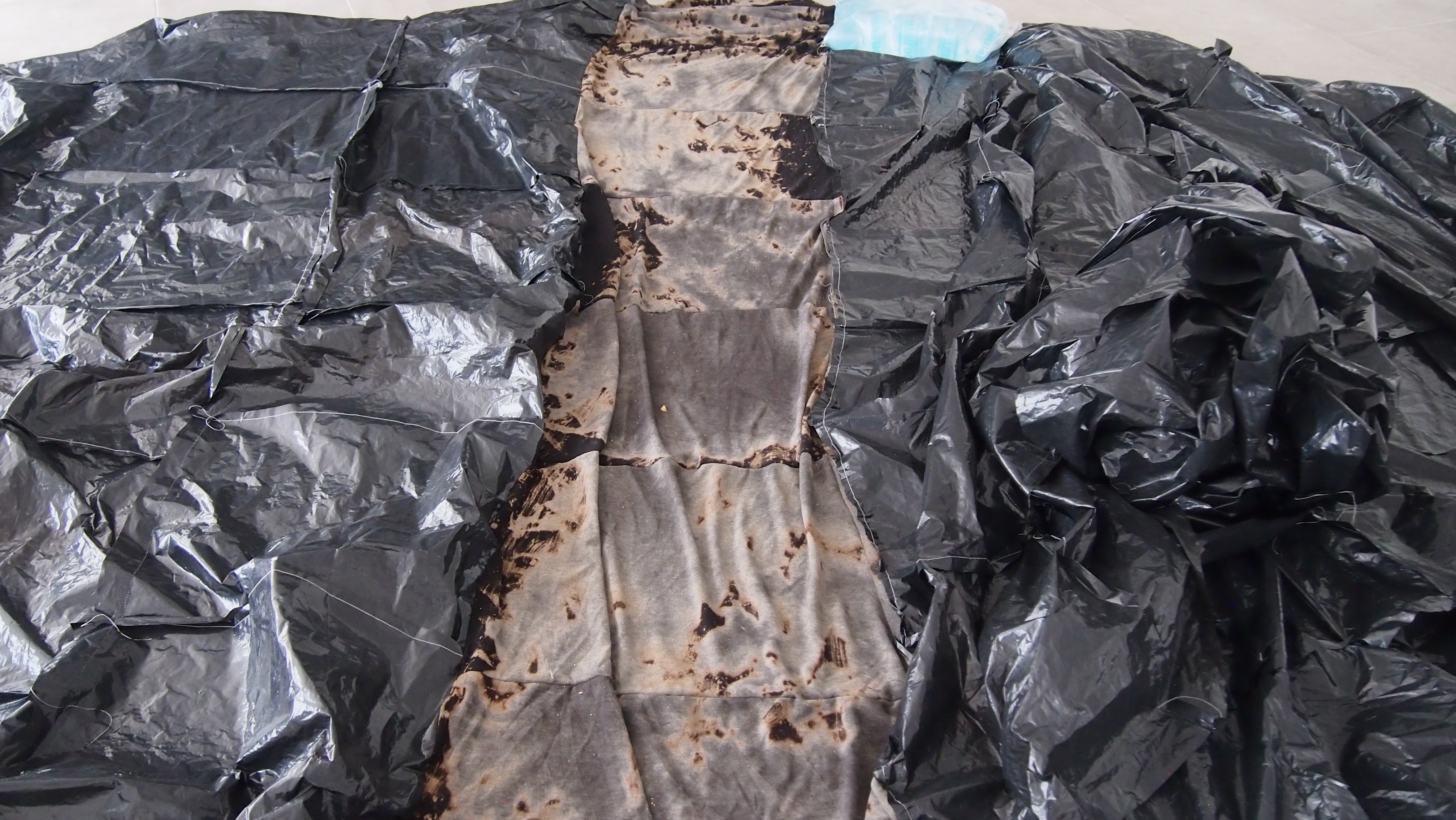The three artists – Olatunde Alara, Ifedoyin Shotunde and Oladotun Oshilaja (Laja) – who have been friends for some years, discuss their upcoming exhibition, ‘Niggas That Can’t Paint’, at Treehouse, the experimental Lagos-based art space founded by Wura-Natasha Ogunji. Inspired by the post-minimalist movement of the 1970s, in particular, the movement’s material irreverence and counter-conventional stance, this group exhibition performs a timely radical inquisition into the current state of contemporary Nigerian art.
Olatunde, two years ago, you had an ‘Anti-Art’ exhibition at Stranger Lagos, inspired by the abstract modernist movements of Euro-America. Now, you, Ifedoyin, and Laja are looking to the post-minimalism movement for inspiration. What attracts you all to these Western (often New York-based) art movements, and to their anti-representational frameworks?
Olatunde: I think for me a big part of it is history – in this case, art history. When I did the Anti-Art exhibition, that was new ground for me; it was like conceptual art and adding that to my narrative as an artist. The visual language I was trying to build upon started growing because of my interest in history so I thought it only made sense to tap into that. I’ve also found that most of what is termed ‘African art’ is very colonial by nature and I feel as though the impact of Africans on human civilisation has been lessened, especially when it comes to abstract art. I’m trying to normalise an artistic approach that is often seen as white or American.
Laja: I’m attracted to post-minimalism for its radical thought and unorthodox approach towards making art. As you might have already noticed, Nigeria’s contemporary art scene isn’t filled up with ideas that scream out towards the radical door. And that’s precisely why I fell in love with the idea. Also, I was looking for an alternative and challenging approach to creating art that drifted away from my prior neo-expressionist style.
Ifedoyin: Post-minimalism might have been properly described or birthed as a concept by Euro-American standards, but it’s an artistic direction that I find extremely relevant for artists operating from within the Nigerian and African climate. I believe post-minimalism is a means of promoting non-elitism in art, in the aspect of production at least, because of the possibilities with material use. We need more room for possibilities; we need to open our art world to a greater number of practitioners. One could conveniently use everyday objects to create amazing experiences.

Olatunde, your work carries a reactionary impulse as its usually trying to challenge the conservative tenets of contemporary Nigerian art. Some would call this impulse avant-garde. Would you? How do you relate to that loaded term?
O: I think that for a lack of better terms, you could describe what I’m doing as avant-garde. What is the definition avant-garde – this idea of experimentation and creating works that challenge any established traditions or notions, whether within the art world or society. But in the sense I feel most people might be using the word, I wouldn’t really regard my work as ‘avant-garde’. This is because of the elitism that people identify with those movements. And in a lot of ways, that sentiment is real – that’s how I’m connecting my own narrative to these art movements. I don’t see myself as part of it. I’m referencing these movements as somebody who hopefully is enough of an outsider, which allows for a more objective point of view. So it’s a matter of nuance.
Art here doesn’t have that reverence for what it can truly be. It is a joke, a commodity, something you take a selfie with. It’s not anything beyond. I like this idea of playing into that.
So are you interested in non-representational art more for its intrinsic aesthetic value or for its critical, reactionary value?
O: It’s a bit of both because when I started out, I wasn’t a formally trained artist. When I returned from England nine years ago, it was a very alienating experience in a lot of ways. Everything was different; there was so much to grapple with on a societal and political level. Because of this, I was producing work from a very intense reactionary space. But as time went on my beliefs about what an artist could do, or not do, or be, grew. So, for me, tapping into these movements isn’t just about the radical value; I also grew to appreciate the aesthetic. I mean, have you ever seen nylon gleaming? When you look at it, it’s just really cool. I like creating these really immense experiences that are still very ordinary. It’s not something that you feel the impact of at first.
Have you ever seen nylon gleaming?
The works in this group exhibition are hyperconscious about materiality – they utilise nylon, suede, canvas, egg shells, toilet paper, wood and plastic. Why this material turn? Is it more about the symbolic or the aesthetic dimension of the materials?
I: For me it’s both. These materials are very readily available cheap objects. Some can even be gotten off the streets. This approach towards making art is practical for the Nigerian art scene. For those who want to engage but feel like they can’t due to restrictions that involve lack of resources, this is a way out. Of course there are Nigerian artists that make art out of similar everyday objects, but the issue is that the average person doesn’t know that these things are being taken seriously, or that they can monetize art independent of their ability to draw or paint.
About aesthetics, I have been drawn to the idea of using materials in ways that may inform other possibilities for their usage for a while, more so in the past two years. In 2017, I created a body of work that directly informed a part of my contribution to this installation, but the intention was different then. I got bored of painting on flat surfaces and wanted a sort of solid richness to my canvas so experimented for a bit and settled for the incorporation of eggshells and toilet paper in my canvas preparation process.
O: It’s also both. A lot of what I’ve done in the past, even when I’ve collaborated with others, has been a DIY process. The work is not funded by companies or donations. It’s just me using my funds to make it. When I realised I was spending a lot of money, I had to figure out an economically viable way to make art. I thought about conceptual art. I didn’t have to physically create anything to make art. I could just think up a concept and make art around that. For me, this was a very challenging process because I’m more intuitive.
Initially, the work was supposed to be a painting on the wall, something that took up space. As time went one, it slowly evolved to the idea of using basic materials because of accessibility. I thought of nylon (the material of black plastic bags); it seemed to make the most sense because, when I thought of it, I thought about the aesthetics. I got a really large roll of nylon, cut it into little bits and sewed everything together. It took hours to get that done.
Post-minimalism’s aesthetic impetus is what appeals to me the most; the fact that any material could be elevated from its dormant and ignored prescription into high art is just so radical and fascinating.
In terms of challenging the status quo, I feel like there’s something very imposing about nylon. Just this idea of a shining black object in an all-white space; it draws your attention; there’s no reference to anything, it’s just a huge sheet with breaks in between.

Laja, your work for this exhibition has been described as a cube composed of disposed ‘pure water’ bags. This is interesting because I see it as a humorous subversion of the Minimalist cube (á la Tony Smith) and a locally adapted interpretation of post-minimalism. Can you talk about the thought process behind this work?
L: When I was approached with the post-minimalist theme, I ran through a plethora of materials and execution ideas with Olatunde and Ifedoyin, the most favourable of which was the use of bubble wrap. But as Olatunde mentions, creating a strong physical presence with materials can be very difficult, especially if you are trying to cut production costs.
The minimalist scheme includes stripping the object of any narrative content and I find the cube to be an absolutely appropriate form to convey this idea. Post-minimalism’s aesthetic impetus is what appeals to me the most; the fact that any material could be elevated from its dormant and ignored prescription into high art is just so radical and fascinating.
From what I understand, you’ve mostly worked in a two-dimensional manner. Why the sculptural shift?
L: Being an artist is a lifelong adventure. Explorations of materials, ideas, theories and states of mind keep changing as your practice progresses. I absolutely find it hard to believe, and relate to, artists that keep producing the same thing for very extensive periods of time. I’m entirely open to any ideas or art forms, sculpture included.
I believe there’s been a strong focus on the monetization of art that hinders the potential of African – more particularly Nigerian artists – on a great level.
Olatunde, I remember you mentioning in a prior conversation that the Nigerian artist’s obsession with technical skill is tied to a colonially-induced aspiration to whiteness? Can you talk more about that and the installed works’ championing of an unpolished DIY aesthetic?
O: On a short note, “Niggas wanna be white”. On a note that expands on that, it’s all part of the colonial project – this is the legacy, the damage. When we think of slavery or colonisation, a lot of it is still abstract to us. Every culture is built on some form of anti-blackness. I’m trying to challenge that not just as an aesthetic but also from an intellectual standpoint.
The DIY approach is also driven by an anti-commodity ethos. The works are not things people can buy; they are site-specific. For me, this removes the burden of creating works that reinforce white supremacy. However, I’m not going to spend my life creating politically charged work. Hopefully, the artistic process itself will be the defining way to challenge things.
Post-minimalism might have been properly described or birthed as a concept by Euro-American standards, but it’s an artistic direction that I find extremely relevant for artists operating from within the Nigerian and African climate.
You have used the term ‘Niggas’ in your exhibition title and argue that it has been stripped of its racialised context because of its deployment in a supposedly non-racialised environment. Do you consider Nigeria to be non-racialised?
O: No, I think Nigeria is really racialised. When I said that, it’s specific to how racial identities operate in Nigeria. I’m not saying the word ‘Nigga’ isn’t racialised or politicised in Nigeria, of course it is. But it’s also a thing that marginalised groups can reclaim certain words that have affected them. One thing I find very present here is this idea of respectability politics, which is tied into classicism. It’s very much a racial thing too; it’s a hierarchy; somebody has to be better than somebody.
The exhibition “Niggas That Can’t Paint” opens at The Treehouse, Ikoyi, Lagos, on Saturday, February 29 2020, with a closing artist conversation on Saturday, March 7, 2020
–
Kojo Abudu is a writer based in London, UK and Lagos, Nigeria. He won the 2019
Frieze Writer’s Prize.




